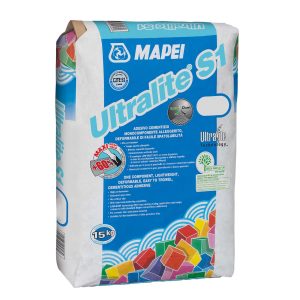APPLICATION
Bonding of ceramic tiles and mosaic tiles on floors and walls, both indoor and outdoor. Also suitable for spot bonding of insulation materials, such as polystyrene foam, rock wool, glass wool, sound insulating boards tc.
Application examples
Bonding of ceramic tiles and mosaic tiles, if properly pre-treated, to the following substrates:
- provide walls with traditional plaster or cement mortar;
- aerated concrete block walls indoors;
- gypsum or anhydrite after pretreatment with Primer G;
- drywall;
- floors equipped with underfloor heating;
- cement screeds, provided they are sufficiently cured and dry;
- Painted interior walls with a well adhering coat of paint.
- Tile existing tile floors with ceramic and natural stone tiles, provided they are firmly attached to the substrate and are crack-free.
TECHNICAL FEATURES
Adesilex P9 is a gray or white powder composed of cement, fine aggregates, synthetic resins and special additives, developed in MAPEI’s research laboratories. Adesilex P9 white is a super white powder with excellent workability. After mixing with water, a mortar with the following properties is produced:
- easy to process;
- strongly thixotropic;
- Adesilex P9 can be applied to vertical surfaces without dripping and without tiles, even heavy ones, dropping down;
- Perfect adhesion to virtually all materials used in construction;
- Cures with minimal shrinkage;
- longer open time.
CONSUMPTION
Bonding of ceramic tiles
- Mosaic and small sizes in general (adhesive comb tooth 4×4 mm): 2 kg/m2
- Normal sizes (notched trowel 5×5 mm): 2.5-3 kg/m2
- Large sizes, outdoor flooring (glue comb teeth 6×6 mm):
Pointwise bonding 5 kg/m2.
- Foam, etc. – approximately 0.5-0.8 kg/m2
- Gypsum board, aerated concrete: approximately 1.5 kg/m2.









Reviews
There are no reviews yet.